duty自恋型人格障碍英文简介
- 格式:pptx
- 大小:1.21 MB
- 文档页数:10
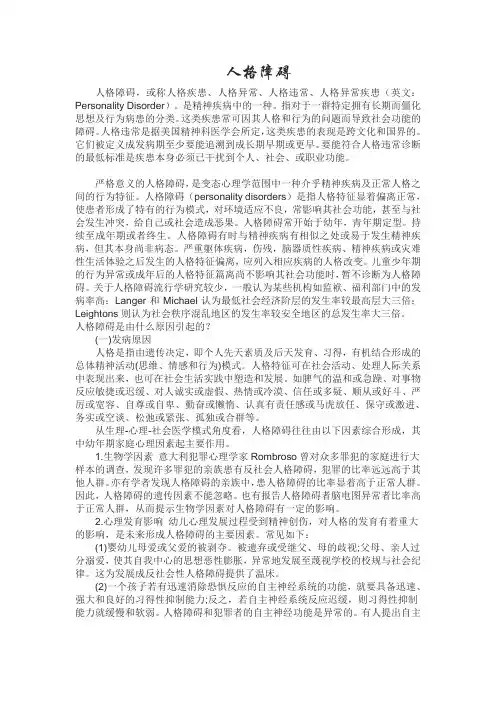
人格障碍人格障碍,或称人格疾患、人格异常、人格违常、人格异常疾患(英文:Personality Disorder)。
是精神疾病中的一种。
指对于一群特定拥有长期而僵化思想及行为病患的分类。
这类疾患常可因其人格和行为的问题而导致社会功能的障碍。
人格违常是据美国精神科医学会所定,这类疾患的表现是跨文化和国界的。
它们被定义成发病期至少要能追溯到成长期早期或更早。
要能符合人格违常诊断的最低标准是疾患本身必须已干扰到个人、社会、或职业功能。
严格意义的人格障碍,是变态心理学范围中一种介乎精神疾病及正常人格之间的行为特征。
人格障碍(personality disorders)是指人格特征显着偏离正常,使患者形成了特有的行为模式,对环境适应不良,常影响其社会功能,甚至与社会发生冲突,给自己或社会造成恶果。
人格障碍常开始于幼年,青年期定型。
持续至成年期或者终生。
人格障碍有时与精神疾病有相似之处或易于发生精神疾病,但其本身尚非病态。
严重躯体疾病,伤残,脑器质性疾病、精神疾病或灾难性生活体验之后发生的人格特征偏离,应列入相应疾病的人格改变。
儿童少年期的行为异常或成年后的人格特征篇离尚不影响其社会功能时,暂不诊断为人格障碍。
关于人格障碍流行学研究较少,一般认为某些机构如监袱、福利部门中的发病率高;Langer和Michael认为最低社会经济阶层的发生率较最高层大三倍;Leightons则认为社会秩序混乱地区的发生率较安全地区的总发生率大三倍。
人格障碍是由什么原因引起的?(一)发病原因人格是指由遗传决定,即个人先天素质及后天发育、习得,有机结合形成的总体精神活动(思维、情感和行为)模式。
人格特征可在社会活动、处理人际关系中表现出来,也可在社会生活实践中塑造和发展。
如脾气的温和或急躁、对事物反应敏捷或迟缓、对人诚实或虚假、热情或冷漠、信任或多疑、顺从或好斗、严厉或宽容、自尊或自卑、勤奋或懒惰、认真有责任感或马虎放任、保守或激进、务实或空谈、松弛或紧张、孤独或合群等。
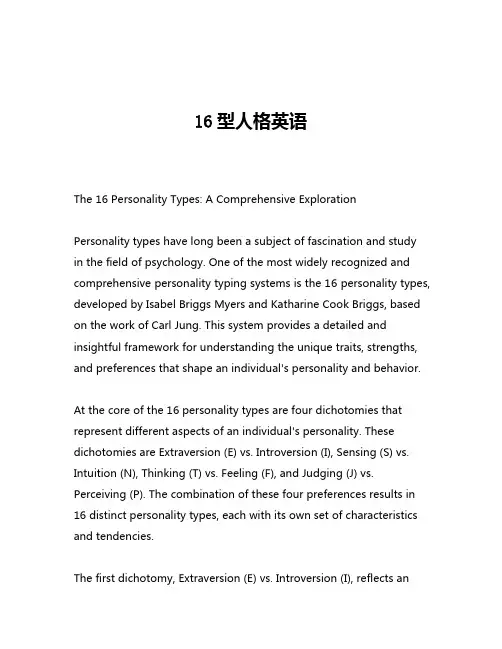
16型人格英语The 16 Personality Types: A Comprehensive ExplorationPersonality types have long been a subject of fascination and study in the field of psychology. One of the most widely recognized and comprehensive personality typing systems is the 16 personality types, developed by Isabel Briggs Myers and Katharine Cook Briggs, based on the work of Carl Jung. This system provides a detailed and insightful framework for understanding the unique traits, strengths, and preferences that shape an individual's personality and behavior.At the core of the 16 personality types are four dichotomies that represent different aspects of an individual's personality. These dichotomies are Extraversion (E) vs. Introversion (I), Sensing (S) vs. Intuition (N), Thinking (T) vs. Feeling (F), and Judging (J) vs. Perceiving (P). The combination of these four preferences results in 16 distinct personality types, each with its own set of characteristics and tendencies.The first dichotomy, Extraversion (E) vs. Introversion (I), reflects anindividual's orientation towards the external world or their inner world. Extraverted individuals tend to be more outgoing, energetic, and focused on the external environment, while introverted individuals are more introspective, reserved, and focused on their internal experiences.The second dichotomy, Sensing (S) vs. Intuition (N), refers to an individual's preferred method of gathering and processing information. Sensing types tend to be more practical, detail-oriented, and focused on the immediate, tangible aspects of reality, while intuitive types are more abstract, imaginative, and focused on patterns, possibilities, and the big picture.The third dichotomy, Thinking (T) vs. Feeling (F), reflects an individual's preferred decision-making process. Thinking types tend to be more logical, analytical, and objective in their decision-making, while feeling types are more empathetic, values-driven, and subjective in their decision-making.The fourth and final dichotomy, Judging (J) vs. Perceiving (P), relates to an individual's preferred approach to the outside world. Judging types tend to be more organized, structured, and goal-oriented, while perceiving types are more flexible, spontaneous, and adaptable.By combining these four dichotomies, the 16 personality typesemerge, each with its own unique blend of characteristics and preferences. These types include ISTJ (The Logistician), ISFJ (The Defender), INFJ (The Advocate), INTJ (The Architect), ISTP (The Virtuoso), ISFP (The Adventurer), INFP (The Healer), INTP (The Thinker), ESTP (The Entrepreneur), ESFP (The Entertainer), ENFP (The Campaigner), ENTP (The Debater), ESTJ (The Executive), ESFJ (The Caregiver), ENFJ (The Protagonist), and ENTJ (The Commander).Each of these 16 personality types has its own distinct set of strengths, weaknesses, and preferences. For example, ISTJs are known for their reliability, attention to detail, and practical problem-solving skills, while ENFPs are often characterized by their creativity, enthusiasm, and people-oriented nature.Understanding one's own personality type can be immensely valuable, as it can provide insights into our natural tendencies, preferences, and ways of interacting with the world. It can also help us to better understand and appreciate the unique perspectives and strengths of others, fostering more effective communication and collaboration.Moreover, the 16 personality types have practical applications in various areas of life, such as career development, relationship building, and personal growth. By recognizing our own personality type and those of others, we can better navigate the complexities ofwork, relationships, and personal challenges, and find ways to leverage our strengths and address our weaknesses.For instance, individuals with a Thinking (T) preference may excel in roles that require analytical and problem-solving skills, such as engineering or finance, while those with a Feeling (F) preference may thrive in roles that involve empathy, collaboration, and people-oriented tasks, such as counseling or human resources.Similarly, in relationships, understanding personality types can help individuals communicate more effectively, resolve conflicts, and build deeper connections. An Extravert (E) may appreciate the need for social interaction and excitement, while an Introvert (I) may value more quiet, introspective time.Ultimately, the 16 personality types offer a rich and nuanced understanding of human personality, providing a framework for self-discovery, personal growth, and more effective interactions with others. By embracing the diversity of personality types and recognizing the unique strengths and perspectives they bring, we can cultivate a richer, more fulfilling, and more harmonious world.。
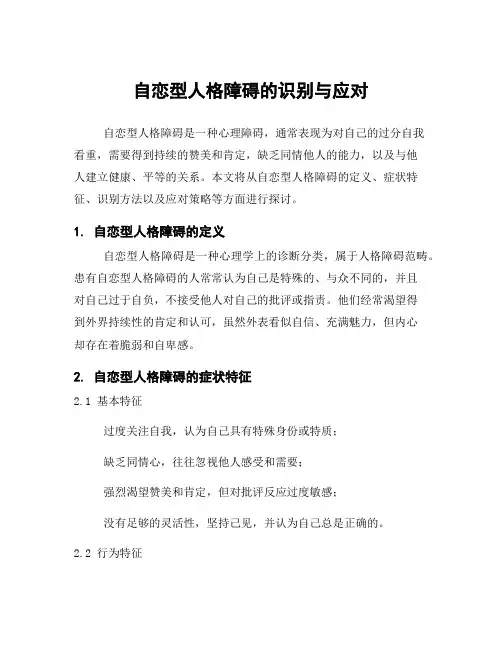
自恋型人格障碍的识别与应对自恋型人格障碍是一种心理障碍,通常表现为对自己的过分自我看重,需要得到持续的赞美和肯定,缺乏同情他人的能力,以及与他人建立健康、平等的关系。
本文将从自恋型人格障碍的定义、症状特征、识别方法以及应对策略等方面进行探讨。
1. 自恋型人格障碍的定义自恋型人格障碍是一种心理学上的诊断分类,属于人格障碍范畴。
患有自恋型人格障碍的人常常认为自己是特殊的、与众不同的,并且对自己过于自负,不接受他人对自己的批评或指责。
他们经常渴望得到外界持续性的肯定和认可,虽然外表看似自信、充满魅力,但内心却存在着脆弱和自卑感。
2. 自恋型人格障碍的症状特征2.1 基本特征过度关注自我,认为自己具有特殊身份或特质;缺乏同情心,往往忽视他人感受和需要;强烈渴望赞美和肯定,但对批评反应过度敏感;没有足够的灵活性,坚持己见,并认为自己总是正确的。
2.2 行为特征常常谈论自己多于倾听他人;对他人成就缺乏真诚的祝贺或赞扬;在人际关系中表现出支配欲和优越感;难以建立相互尊重、平等的关系。
3. 自恋型人格障碍的识别方法要识别一个人是否患有自恋型人格障碍,并不是一件容易的事情。
因为许多人在某种程度上都具备某些自恋型人格障碍患者的特征。
然而,如果一个人同时表现出以下几点,则需要警惕可能存在自恋型人格障碍: - 过分追求成功和权力; - 对批评反应过度敏感; - 缺乏同情心,忽视他人感受。
在识别时,建议寻求专业心理医生或心理咨询师的帮助,进行全面评估和诊断。
4. 自恋型人格障碍的应对策略4.1 个体心理治疗通过个体心理治疗,如认知行为疗法、精神分析等方式来帮助患者认识到自己过度追求肯定和优越感的问题,并逐步调整这种不健康的心态。
4.2 家庭治疗家庭治疗可以帮助患者与家庭成员建立更健康、和谐的关系模式,减少患者对赞美和肯定的依赖,并提高其与他人沟通交流的能力。
4.3 社会支持鼓励患者加入社会团体或群体活动,增加社交机会和社会支持体系,建立更全面、积极健康的社交网络。
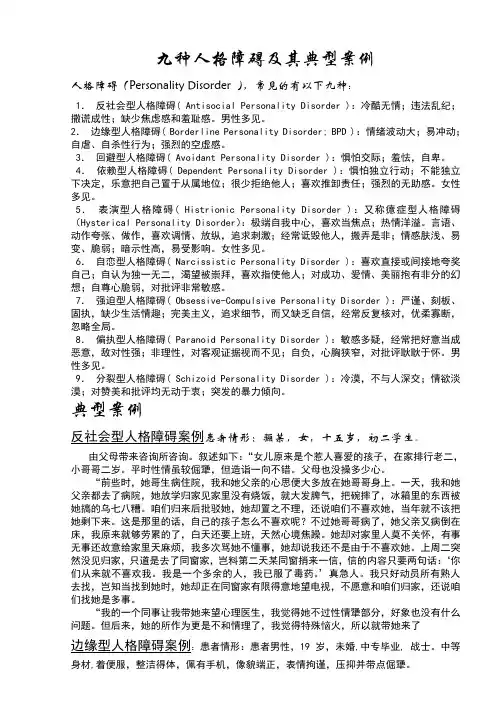
九种人格障碍及其典型案例人格障碍(Personality Disorder ),常见的有以下九种:1.反社会型人格障碍( Antisocial Personality Disorder ):冷酷无情;违法乱纪;撒谎成性;缺少焦虑感和羞耻感。
男性多见。
2.边缘型人格障碍( Borderline Personality Disorder; BPD ):情绪波动大;易冲动;自虐、自杀性行为;强烈的空虚感。
3.回避型人格障碍( Avoidant Personality Disorder ):惧怕交际;羞怯,自卑。
4.依赖型人格障碍( Dependent Personality Disorder ):惧怕独立行动;不能独立下决定,乐意把自己置于从属地位;很少拒绝他人;喜欢推卸责任;强烈的无助感。
女性多见。
5.表演型人格障碍( Histrionic Personality Disorder ):又称癔症型人格障碍(Hysterical Personality Disorder):极端自我中心,喜欢当焦点;热情洋溢。
言语、动作夸张、做作,喜欢调情、放纵,追求刺激;经常诋毁他人,搬弄是非;情感肤浅、易变、脆弱;暗示性高,易受影响。
女性多见。
6.自恋型人格障碍( Narcissistic Personality Disorder ):喜欢直接或间接地夸奖自己;自认为独一无二,渴望被崇拜,喜欢指使他人;对成功、爱情、美丽抱有非分的幻想;自尊心脆弱,对批评非常敏感。
7.强迫型人格障碍( Obsessive-Compulsive Personality Disorder ):严谨、刻板、固执,缺少生活情趣;完美主义,追求细节,而又缺乏自信,经常反复核对,优柔寡断,忽略全局。
8.偏执型人格障碍( Paranoid Personality Disorder ):敏感多疑,经常把好意当成恶意,敌对性强;非理性,对客观证据视而不见;自负,心胸狭窄,对批评耿耿于怀。
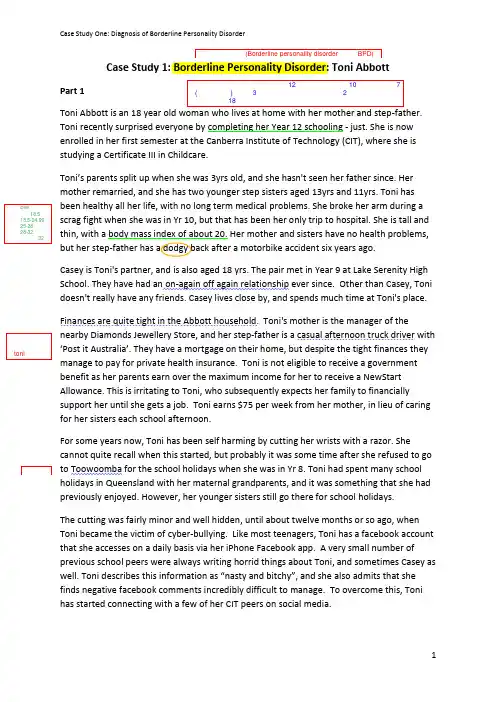
Case Study 1: Borderline Personality Disorder: Toni Abbott Part 1Toni Abbott is an 18 year old woman who lives at home with her mother and step-father. Toni recently surprised everyone by completing her Year 12 schooling - just. She is now enrolled in her first semester at the Canberra Institute of Technology (CIT), where she is studying a Certificate III in Childcare.Toni’s parents split up when she was 3yrs old, and she hasn't seen her father since. Hermother remarried, and she has two younger step sisters aged 13yrs and 11yrs. Toni has been healthy all her life, with no long term medical problems. She broke her arm during a scrag fight when she was in Yr 10, but that has been her only trip to hospital. She is tall and thin, with a body mass index of about 20. Her mother and sisters have no health problems, but her step-father has a dodgy back after a motorbike accident six years ago.Casey is Toni's partner, and is also aged 18 yrs. The pair met in Year 9 at Lake Serenity High School. They have had an on-again off again relationship ever since. Other than Casey, Toni doesn't really have any friends. Casey lives close by, and spends much time at Toni's place.Finances are quite tight in the Abbott household. Toni's mother is the manager of the nearby Diamonds Jewellery Store, and her step-father is a casual afternoon truck driver with ‘Post it Australia’. They have a mortgage on their home, but despite the tight finances they manage to pay for private health insurance. Toni is not eligible to receive a government benefit as her parents earn over the maximum income for her to receive a NewStart Allowance. This is irritating to Toni, who subsequently expects her family to financially support her until she gets a job. Toni earns $75 per week from her mother, in lieu of caring for her sisters each school afternoon.For some years now, Toni has been self harming by cutting her wrists with a razor. She cannot quite recall when this started, but probably it was some time after she refused to go to Toowoomba for the school holidays when she was in Yr 8. Toni had spent many school holidays in Queensland with her maternal grandparents, and it was something that she had previously enjoyed. However, her younger sisters still go there for school holidays.The cutting was fairly minor and well hidden, until about twelve months or so ago, when Toni became the victim of cyber-bullying. Like most teenagers, Toni has a facebook account that she accesses on a daily basis via her iPhone Facebook app. A very small number of previous school peers were always writing horrid things about Toni, and sometimes Casey as well. Toni describes this information as “nasty and bitchy”, and she also admits that she finds negative facebook comments incredibly difficult to manage. To overcome this, Toni has started connecting with a few of her CIT peers on social media.边缘性人格障碍 (Borderline personality disorder,简称BPD)。
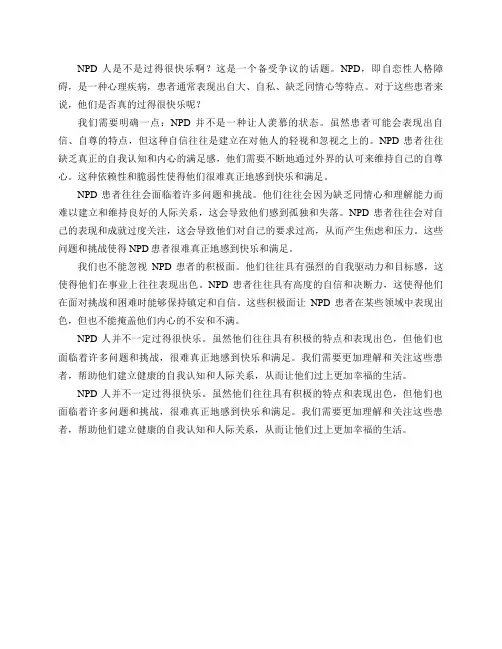
NPD人是不是过得很快乐啊?这是一个备受争议的话题。
NPD,即自恋性人格障碍,是一种心理疾病,患者通常表现出自大、自私、缺乏同情心等特点。
对于这些患者来说,他们是否真的过得很快乐呢?我们需要明确一点:NPD并不是一种让人羡慕的状态。
虽然患者可能会表现出自信、自尊的特点,但这种自信往往是建立在对他人的轻视和忽视之上的。
NPD患者往往缺乏真正的自我认知和内心的满足感,他们需要不断地通过外界的认可来维持自己的自尊心。
这种依赖性和脆弱性使得他们很难真正地感到快乐和满足。
NPD患者往往会面临着许多问题和挑战。
他们往往会因为缺乏同情心和理解能力而难以建立和维持良好的人际关系,这会导致他们感到孤独和失落。
NPD患者往往会对自己的表现和成就过度关注,这会导致他们对自己的要求过高,从而产生焦虑和压力。
这些问题和挑战使得NPD患者很难真正地感到快乐和满足。
我们也不能忽视NPD患者的积极面。
他们往往具有强烈的自我驱动力和目标感,这使得他们在事业上往往表现出色。
NPD患者往往具有高度的自信和决断力,这使得他们在面对挑战和困难时能够保持镇定和自信。
这些积极面让NPD患者在某些领域中表现出色,但也不能掩盖他们内心的不安和不满。
NPD人并不一定过得很快乐。
虽然他们往往具有积极的特点和表现出色,但他们也面临着许多问题和挑战,很难真正地感到快乐和满足。
我们需要更加理解和关注这些患者,帮助他们建立健康的自我认知和人际关系,从而让他们过上更加幸福的生活。
NPD人并不一定过得很快乐。
虽然他们往往具有积极的特点和表现出色,但他们也面临着许多问题和挑战,很难真正地感到快乐和满足。
我们需要更加理解和关注这些患者,帮助他们建立健康的自我认知和人际关系,从而让他们过上更加幸福的生活。
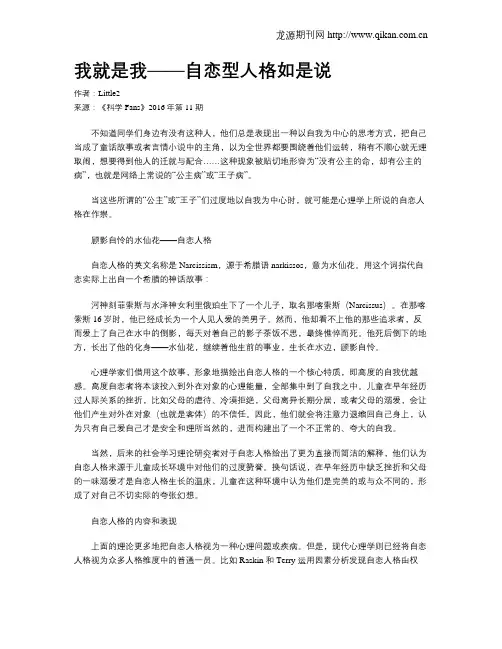
我就是我——自恋型人格如是说作者:Little2来源:《科学Fans》2016年第11期不知道同学们身边有没有这种人,他们总是表现出一种以自我为中心的思考方式,把自己当成了童话故事或者言情小说中的主角,以为全世界都要围绕着他们运转,稍有不顺心就无理取闹,想要得到他人的迁就与配合……这种现象被贴切地形容为“没有公主的命,却有公主的病”,也就是网络上常说的“公主病”或“王子病”。
当这些所谓的“公主”或“王子”们过度地以自我为中心时,就可能是心理学上所说的自恋人格在作祟。
顾影自怜的水仙花——自恋人格自恋人格的英文名称是Narcissism,源于希腊语narkissos,意为水仙花。
用这个词指代自恋实际上出自一个希腊的神话故事:河神刻菲索斯与水泽神女利里俄珀生下了一个儿子,取名那喀索斯(Narcissus)。
在那喀索斯16岁时,他已经成长为一个人见人爱的美男子。
然而,他却看不上他的那些追求者,反而爱上了自己在水中的倒影,每天对着自己的影子茶饭不思,最终憔悴而死。
他死后倒下的地方,长出了他的化身——水仙花,继续着他生前的事业,生长在水边,顾影自怜。
心理学家们借用这个故事,形象地描绘出自恋人格的一个核心特质,即高度的自我优越感。
高度自恋者将本该投入到外在对象的心理能量,全部集中到了自我之中。
儿童在早年经历过人际关系的挫折,比如父母的虐待、冷漠拒绝,父母离异长期分居,或者父母的溺爱,会让他们产生对外在对象(也就是客体)的不信任。
因此,他们就会将注意力退缩回自己身上,认为只有自己爱自己才是安全和理所当然的,进而构建出了一个不正常的、夸大的自我。
当然,后来的社会学习理论研究者对于自恋人格给出了更为直接而简洁的解释,他们认为自恋人格来源于儿童成长环境中对他们的过度赞誉。
换句话说,在早年经历中缺乏挫折和父母的一味溺爱才是自恋人格生长的温床,儿童在这种环境中认为他们是完美的或与众不同的,形成了对自己不切实际的夸张幻想。


喜欢吸引别人注意什么病喜欢吸引别人注意的两种病可能是注意力不足障碍(ADHD)和自恋性人格障碍(NPD)。
注意力不足障碍(ADHD)是一种常见的儿童和成人精神障碍,其特点是记忆力差、专注力不足和过度活跃。
个体可能倾向于寻求注意,以获得他人的关注和认可。
这可能表现为喜欢表演、引起注意、过度大声或冲动行为。
这种行为可能是为了满足内心的兴奋和刺激需求,并使他们感到自己的存在被认可、被重视。
他们经常需要持续的外部刺激,因此会寻求别人的关注和反应。
此外,他们也可能对外界刺激很敏感,导致他们在寻求更多、更强烈的刺激来满足自己的需求。
这种病症在儿童中更常见,但也可能在成年人中存在。
自恋性人格障碍(NPD)是一种人格障碍,其特点是对自己的特殊性和重要性高度自负,缺乏对他人的关心和共情能力。
个体往往有着极度的自我中心主义和对自己的自大感。
他们渴望被他人赞美和崇拜,因此他们常常寻求别人的注意和赞美。
这种病症的患者可能表现出炫耀、招摇、自夸等行为,以引起他人的关注和赞赏。
他们常常表现出自我标榜、自我宣传和对他人的嘲笑或轻视。
这种行为目的在于满足他们强烈的自尊心和需求被他人认可的渴望。
换句话说,这两种病可能因个体有着不同的心理需求和基本性格特点而导致。
ADHD患者的内心需要持续的刺激和活动,他们通过吸引别人的注意和反应来满足自己的需求。
NPD患者则出于对自身特殊性的高度评价和自我中心主义的性格特点,渴望被他人注意和赞美,因而表现出引起他人注意的行为。
为了帮助这样的个体,我们应该采取个体化的治疗方法。
对ADHD患者来说,可以通过药物治疗和心理治疗来提高他们的专注力和注意力控制能力。
心理治疗可以帮助他们学会管理自己的行为,理解自己的需求,并找到其他满足这些需求的方式。
对NPD患者来说,治疗的重点应该是帮助他们建立健康的自尊和与他人的关系。
这可以通过情绪调节、增加共情能力和建立互相尊重的关系来实现。
总结而言,喜欢吸引别人注意可能是由注意力不足障碍(ADHD)和自恋性人格障碍(NPD)所导致的。
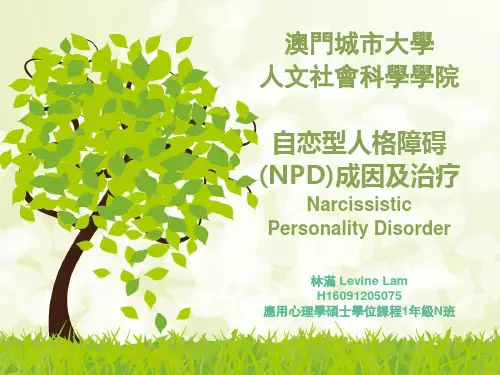
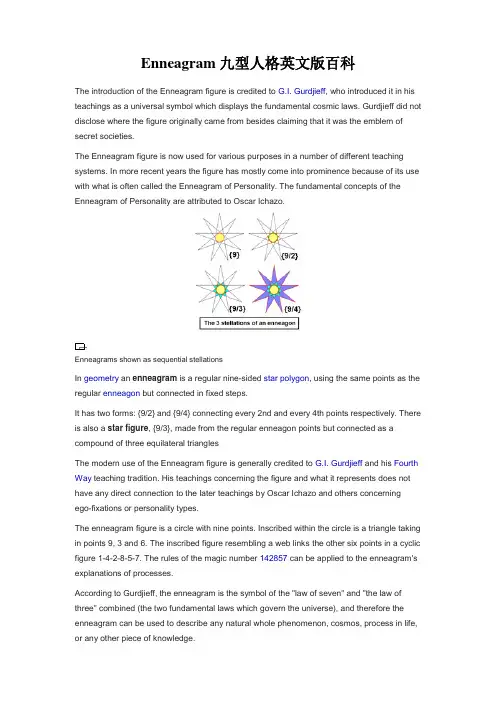
Enneagram九型人格英文版百科The introduction of the Enneagram figure is credited to G.I. Gurdjieff, who introduced it in his teachings as a universal symbol which displays the fundamental cosmic laws. Gurdjieff did not disclose where the figure originally came from besides claiming that it was the emblem of secret societies.The Enneagram figure is now used for various purposes in a number of different teaching systems. In more recent years the figure has mostly come into prominence because of its use with what is often called the Enneagram of Personality. The fundamental concepts of the Enneagram of Personality are attributed to Oscar Ichazo.Enneagrams shown as sequential stellationsIn geometry an enneagram is a regular nine-sided star polygon, using the same points as the regular enneagon but connected in fixed steps.It has two forms: {9/2} and {9/4} connecting every 2nd and every 4th points respectively. There is also a star figure, {9/3}, made from the regular enneagon points but connected as a compound of three equilateral trianglesThe modern use of the Enneagram figure is generally credited to G.I. Gurdjieff and his Fourth Way teaching tradition. His teachings concerning the figure and what it represents does not have any direct connection to the later teachings by Oscar Ichazo and others concerningego-fixations or personality types.The enneagram figure is a circle with nine points. Inscribed within the circle is a triangle taking in points 9, 3 and 6. The inscribed figure resembling a web links the other six points in a cyclic figure 1-4-2-8-5-7. The rules of the magic number 142857 can be applied to the enneagram's explanations of processes.According to Gurdjieff, the enneagram is the symbol of the "law of seven" and "the law of three" combined (the two fundamental laws which govern the universe), and therefore the enneagram can be used to describe any natural whole phenomenon, cosmos, process in life, or any other piece of knowledge.A basic example of the possible usage of the enneagram is that it can be used to illustrateGurdjieff's concept of the evolution of the three types of ‘food’ necessary for a man: ordinary food, air and impressions. Each point on the enneagram in this case would represent the stage and the possibility of further evolution of food at a certain stage in the human body.Most processes on the enneagram are represented through octaves where the points serve as the notes; a concept which is derived from Gur djieff’s idea of the law of seven. In an octave the developing process comes to a critical point (one of the triangle points) at which help fromoutside is needed for it to rightly continue. This concept is best illustrated on the keys of the piano where every white key would represent an enneagram web point. The adjacent white keys which are missing a black key (half note) in between represent the enneagram webpoints which have a triangle point in between. In order that this point would pass onto the next, an external push is required.In the enneagram a process is depicted as going right around the circle beginning at 9 (the ending point of a previous process). The process can continue until it reaches point 3. At point three an external aid is needed in order that the process continues. If it doesn't receive the ‘help’, the process will stop evolving and will devolve back into the form from which it evolved. The process continues until point 6, and later 9, where a similar "push" is needed. If the process passes point 9, the initial process will end, while giving birth to a new one.The line of development associated with the Fourth Way developed from the writings ofGurdjieff's students - principally P.D. Ouspensky, Maurice Nicoll, J.G. Bennett and Rodney Collin. They developed Gurdjieff's ideas and left their own accounts. There is an extensivebibliography devoted to the Gurdjieff-Ouspensky tradition.A Gurdjieff foundation exists which claims an authority based on a line of succession directlythrough Mr Gurdjieff. The foundation preserves Gurdjieff's music and movements andcontinues its own work with the Enneagram figure.The enneagram as a structured process was studied by John G. Bennett and his associates.Bennett showed how it applied to something as mundane as a restaurant as well as tosomething as spiritual as the Beatitudes. It is currently being used to explicate the idea ofself-organization in management.The Enneagram of Personality is derived from (established in U.S. Court 970 F.2d 1067, 1075.2nd Circuit, 1992) partial understandings of the insights of Oscar Ichazo., the Bolivian-born founder of the Arica School (established in 1968). No evidence has appeared before Ichazo's offerings for using the Enneagram figure with concepts such as "ego fixations" or "personality types" or indeed in any way where each point is described in a way that can be viewed as a typology. All historical documentation of this kind of terminology appears only after Ichazo's original teachings.Ichazo claims that sometime in the 1950s he received insight into how certain mechanistic and repetitive thought and behavior patterns can be understood in connection with the Enneagram figure and with what he called Trialectic logic as part of a complete and integrated model of the human psyche. The purpose of Ichazo's teachings was to help people transcend theiridentification with - and the suffering caused by - their own mechanistic thought and behavior patterns.The theory was founded upon the basic premise that all life seeks to continue and perpetuate itself and the human psyche must follow the same common laws of reality as such. From this, Ichazo defined three basic human instincts for survival (Conservation, Relations and Adaptation) and two poles of attraction to self-perpetuation (Sexual and Spiritual). With a baseline of a psyche in a state of unity as a prototypical model, the Fixations were defined as aberrations from this baseline, much as the DSM is an observationally based tool for recognizing personality disorders. In fact, Ichazo has related the Fixations with the DSM Diagnostic and Statistical Manual of Mental Disorders categories to show that Fixations are the precursor to mental illness. Each Fixation is diagnosed from the particular experience of psychological trauma a child suffers when the child's expectations are not met in each respective Instinct. Since a child is completely self-centered in its expectations, it is inevitable that the child will experience disappointment of expectation viewed by the child as a matter of one of the three fundamental attitudes (attracted, unattracted or disinterested are the only possible attitudes), and thus experience trauma and begin to form mechanistic thought and behavior patterns in an attempt to protect itself from experiencing a recurrence of the trauma. This basic, irrefutable understanding of three fundamental Instincts and three possible attitudes along with the understanding that a human being can be in a state of unity, analyzed with Trialectic logic forms a solid foundation upon which the theory of Fixations is based. As such, the theory of ego Fixations has a particular foundation which can be tested. The idea of "Personality Types" is an invention of intuition without any particular foundation beyond the theory of ego Fixations, and as such can be interpreted to mean whatever any of the Enneagram of Personality proponents chooses it to mean whenever they choose to so interpret it. Thus we understand why there is no specific, solid agreement among the various proponents of "Personality" as something objective and anything more than a proposition to obfuscate human suffering.By understanding one's Fixations and through self observation, the hold on the mind, and suffering caused by the Fixations, is reduced and even transcended. There was never an intention or purpose in Ichazo's original work to use this knowledge to reinforce or manipulate what is essentially a source of human suffering. Therefore almost all later interpretations of the Enneagram of Personality are viewed by Ichazo as unfounded and therefore misguided and psychologically harmful as well as spiritually harmful (in the sense of coming to see one's process as such) in light of his original intentions. In other words, the Enneagram Movement can be considered, in most cases, to actually be promoting the strengthening of the basis for the personality disorders we find expositions of in the DSM.From the 1970s Ichazo's partial and misunderstood Enneagram teachings were adapted and developed by a number of others, first by the Chilean-born psychiatrist, Claudio Naranjo, who was a member of a training program in Arica, Chile with Ichazo for some months in 1969. Naranjo taught his understanding of the Enneagram of Personality to a number of his American students, including some Jesuit priests who then taught it to seminarians.It is believed by Enneagram theorists that the points of the Enneagram figure indicate a number of ways in which nine principal ego-archetypal forms or types of human personality (also often called "Enneatypes") are psychologically connected. These nine types are often given names that indicate some of their more distinctively typical characteristics. Such names are insufficient to capture the complexities and nuances of the types which require study and observation to understand in depth.Some brief descriptions of the Enneatypes are as follows:One: Reformer, Critic, Perfectionist - This type focuses on integrity. Ones can be wise, discerning and inspiring in their quest for the truth. They also tend to dissociate themselves from their flaws or what they believe are flaws (such as negative emotions) and can become hypocritical and hyper-critical of others, seeking the illusion of virtue to hide their own vices. The One's greatest fear is to be flawed and their ultimate goal is perfection. The corresponding "deadly sin" Ones is Anger and their "holy idea" or essence is Holy Perfection. Under stress Ones express qualities of Fours and when relaxed qualities of Sevens.Two: Helper, Giver, Caretaker - Twos, at their best, are compassionate, thoughtful and astonishingly generous; they can also be prone to passive-aggressive behavior, clinginess and manipulation. Twos want, above all, to be loved and needed and fear being unworthy of love. The corresponding "deadly sin" of Twos is Pride and their "holy idea" or essence is Holy Will. Under stress Twos express qualities of Eights and when relaxed qualities of Fours.Three: Achiever, Performer, Succeeder - Highly adaptable and changeable. Some walk the world with confidence and unstinting authenticity; others wear a series of public masks, acting the way they think will bring them approval and losing track of their true self. Threes are motivated by the need to succeed and to be seen as successful. The corresponding "deadly sin" of Threes is Deceit and their "holy idea" or essence is Holy Law. Under stress Threes express qualities of Nines and when relaxed qualities of Sixes.Four: Romantic, Individualist, Artist - Driven by a desire to understand themselves and find a place in the world they often fear that they have no identity or personal significance. Fours embrace individualism and are often profoundly creative and intuitive. However, they have a habit of withdrawing to internalize, searching desperately inside themselves for something they never find and creating a spiral of depression. The corresponding "deadly sin" of Fours is Envy and their "holy idea" or essence is Holy Origin. Under stress Fours express qualities of Twos and when relaxed qualities of Ones.Five: Observer, Thinker, Investigator - Fives are motivated by the desire to understand the world around them, specifically in terms of facts. Believing they are only worth what they contribute, Fives have learned to withdraw, to watch with keen eyes and speak only when they can shake the world with their observations. Sometimes they do just that. However, some Fives are known to withdraw from the world, becoming reclusive hermits and fending off social contact with abrasive cynicism. Fives fear incompetency or uselessness and want to be capable and knowledgeable above all else. The corresponding "deadly sin" of the Five isAvarice and their "holy idea" or essence is Holy Omniscience. Under stress Fives express qualities of Sevens and when relaxed qualities of Eights.Six: Loyalist, Devil's Advocate, Defender - Sixes long for stability above all else. They exhibit unwavering loyalty and responsibility, but once betrayed, they are slow to trust again. They are prone to extreme anxiety and passive-aggressive behavior. Their greatest fear is to lack support and guidance. The corresponding "deadly sin" of the Six is Cowardice and their "holy idea" or essence is Holy Faith and Strength. Under stress Sixes express qualities of Threes and when relaxed qualities of Nines. There are two kinds of Sixes - phobic and counterphobic. Phobic Sixes have a tendency to run or hide from things they fear while counterphobic Sixes are more likely to confront their fears.Seven: Enthusiast, Adventurer, Materialist, Epicure - Sevens are adventurous, and busy with many activities with all the energy and enthusiasm of the Puer Aeternus. At their best they embrace life for its varied joys and wonders and truly live in the moment; but at their worst they dash frantically from one new experience to another, too scared of disappointment to actually enjoy themselves. Sevens fear being unable to provide for themselves or to experience life in all of its richness. The corresponding "deadly sin" of Sevens is Gluttony and their "holy idea" or essence is Holy Wisdom". Under stress Sevens express qualities of Ones and when relaxed qualities of Fives.Eight: Leader, Protector, Challenger - Eights value personal strength and they desire to be powerful and in control. They concern themselves with self-preservation. They are natural leaders, who can be either friendly and charitable or dictatorially manipulative, ruthless, and willing to destroy anything in their way. Eights seek control over their own lives and destinies, and fear being harmed or controlled by others. The corresponding "deadly sin" of the Eight is Lust and their "holy idea" or essence is Holy Truth. Under stress Eights express qualities of Fives and when relaxed qualities of Twos.Nine: Mediator, Peacemaker, Preservationist - Nines are ruled by their empathy. At their best they are perceptive, receptive, gentle, calming and at peace with the world. On the other hand, they prefer to dissociate from conflicts; they indifferently go along with others' wishes, or simply withdraw, acting via inaction. They fear the conflict caused by their ability to simultaneously understand opposing points of view and seek peace of mind above all else. The corresponding "deadly sin" of the Nine is Sloth and their "holy idea" or essence is Holy Love. Under stress Nines express qualities of Sixes and when relaxed qualities of Threes.Whilst a person's Enneatype is determined by only one of the ego-fixations, their personality characteristics are also influenced and modified in different ways by all of the other eight fixations as well.Most Enneagram teachers and theorists believe that one of the principal kinds of influence and modification come from the two points on either side of their Enneatype. These two points are known as the 'Wings'.Observation seems to indicate, for example, that Ones will tend to manifest some characteristics of both Nines and Twos. Some Enneagram theorists believe that one of theWings will always have a more dominant influence on an individual's personality, while others believe that either Wing can be dominant at any particular time depending on the person's circumstances and development.This aspect of Enneagram theory was originally suggested by Claudio Naranjo and then further developed by some of the Jesuit teachers.The lines of the triangle and hexagon are believed to indicate psychological dynamics between the points connected depending on whether a person is in a more stressed or secure and relaxed state. Therefore the connecting points on the lines are usually called the 'Stress Points' and 'Security Points'. In Don Riso's teachings these lines are also called the 'Directions of Integration' and the 'Directions of Disintegration' as he believes that the security points also indicates the 'direction' towards greater psychological wellbeing and the stress points towards psychological breakdown.The more traditional understanding of the stress and security points is that when people are in a more secure or relaxed state they will tend to express aspects of the 'security' or 'integration' type associated with their main type and aspects of the other direction when stressed. Relaxed or secure Ones, for instance, will tend to manifest some more positive aspects of the Seven personality type, Ones tending to be highly self-inhibitory whereas Sevens give themselves permission to enjoy the moment. On the other hand, stressed Ones will express some more negative aspects of the Four personality, particularly the obsessive introspection; they also share a certain amount of self-loathing and self-inhibition.Another emerging belief about these connections between points is that people may access and express the positive and negative aspects of both points depending on their particular circumstances.The connecting points are often indicated on Enneagram figures by the use of arrows and are sometimes also called 'Arrow Points'. The sequence of stress points is 1-4-2-8-5-7-1 for the hexagon and 9-6-3-9 for the triangle. The security points sequence is in the opposite direction (1-7-5-8-2-4-1 and 9-3-6-9). These sequences are found in the repeating decimals resulting from division by 7 and 3, respectively, both of those numbers being important to Gurdjieff's system. (1/7 = 0.1428571...; 1/3 = 0.3333..., 2/3 = 0.6666..., 3/3 = 0.9999...).Each type also has three main instinctual subtypes - the Self-Preservation, Sexual and Social subtypes. Because each point is different, it may be perceived as having a tendency toward one subtype or another. It requires keen observation and understanding to discover a person's tendency toward a particular subtype.▪Self-Preservation subtypes pay most attention to physical survival needs.▪Sexual subtypes focus most on intimacy and one-to-one relationships.▪Social subtypes care most about others, in groups and communities.These are very similar to the "need areas" of the FIRO-B instrument, called "Inclusion" "Control" and "Affection", except that the score in each area carries equal weight in the person's overal personality, and there is no "tendency" towards one or another.▪One –Anger, as the frustration that comes from Ones working hard to do things right while the rest of the world doesn't care about doing things right and not appreciating the sacrifices and efforts Ones have made.▪Two –Pride, as self-inflation of the ego, in the sense of Twos seeing themselves as indispensable to others and to having no needs whilst also being needed by others.▪Three –Deceit, in the misrepresentation of self by marketing and presenting an image valued by others rather than presenting an authentic self.▪Four –Envy of someone else reminds Fours that they can never be what another person is, reawakening their sense of self-defectiveness.▪Five –Avarice, as the hoarding of resources in an attempt to minimize their needs in the face of a world that takes more than it gives; thus isolating Fives from the world.▪Six –Fear, often in the form of a generalized anxiety that can't find an actual source of fear. Sixes may wrongly identify a source of fear through projection, possibly seeingenemies and dangers where there are none.▪Seven –Gluttony, not in the sense of eating too much but, rather, of sampling everything the world has to offer (breadth) and not taking the time for richer experience (depth).▪Eight –Lust, in the sense of wanting more of what Eights find stimulating, to a point beyond which most people would feel overwhelmed and stop.▪Nine –Sloth, or laziness in discovering a personal agenda and instead choosing the less problematic strategy of just going along with other people's agendas.Because of differences among teachers in their understanding of the personality characteristics of the nine types and more theoretical aspects of Enneagram dynamics some skeptics argue that more research needs to be done to test the Enneagram as an empirically valid typology.While some believe that current research does not support the Enneagram's validity (especially regarding the concepts of Wings and the Stress and Security Points), others believe that because of its complex and 'spiritual' nature the Enneagram typology cannot be accurately evaluated by conventional empirical methods.Recently published research (2005) based on a type indicator questionnaire developed by Don Riso and Russ Hudson [3] claims to have demonstrated that the nine Enneagram types are "real and objective". Katherine Chernick Fauvre also claims to have statistically validated research that indicates that the three Instinctual Subtypes are real and objective.[citation needed] Concerning the brain, at least three different models have been proposed for identifying a basis for the Enneagram in neuroscience:▪Asymmetry in PFC and amygdala activity▪Triune brain▪Differential neurotransmitter activityConcerning the first brain model, a partially finished book entitled "Personality and the Brain" was posted for free download in December 2005. This book, written by a self-described "hacker", presents a model for linking the Enneagram to the current findings of neuroscience regarding prefrontal cortex (PFC) and amygdala asymmetry.Concerning the second brain model, The Enneagram and the Triune Brain offers a different theory on the neuroscience of Enneagram. This article was originally published in the October 2000 issue of the Enneagram Monthly and links the Enneagram with Paul MacLean's triune brain theory.In his 1996 book The Emotional Brain: The Mysterious Underpinnings of Emotional Life (at pages 92-103 of the paperback version), neuroscientist Joseph LeDoux rejected McLean's triune brain model to the extent that this model limits emotional functions to what McLean called the "limbic system". LeDoux explains that emotional functions are not limited to the limbic system (e.g. areas of the neocortex also play various roles); conversely, the limbic system is not limited to emotional functions (e.g. that area also processes certain cognitive functions). If LeDoux's criticisms of the triune brain theory are correct this would obviate this second model as a useful basis for the Enneagram in neuroscience.Concerning the third brain model, the paper The Enneagram and Brain Chemistry offers a theory that the different Enneagram types derive from different activity levels of the neurotransmitters serotonin, norepinephrine, and dopamine.Some psychologists and researchers regard the Enneagram as a pseudoscience that uses an essentially arbitrary set of personality dimensions to make its characterizations. Such critics assert that claims for the Enneagram's validity cannot be verified using the empirical scientific method as they lack falsifiability and cannot be disproven. In this respect, the Enneagram is not considered to be any different from many other typological models, such as that of Carl Gustav Jung on which the Myers-Briggs Type Indicator is based.The Pontifical Council for Culture and the Pontifical Council for Interreligious Dialogue of the Roman Catholic Church have also expressed concerns about the Enneagram when it is used in a religious context, because it is claimed that it "introduces an ambiguity in the doctrine and the life of the Christian faith". [4]Some critics suspect that the claims for the Enneagram's validity may be attributed to the Forer effect, the tendency for people to believe a supposedly tailored description of themselves even when the description has been worded in very broad terms.。
双相情感障碍英语介绍Bipolar disorder, also known as manic-depressive illness, is a mental health condition characterized by extreme mood swings that include emotional highs (mania or hypomania) and lows (depression). These mood shifts can affect a person's ability to function in daily life. Here's an introduction to bipolar disorder in English:Bipolar Disorder: An OverviewBipolar disorder affects millions of people worldwide and is a complex mental health condition that requires careful management and understanding. It is not simply a case of having extreme ups and downs; rather, it is a chronic illness that can be life-altering for those who suffer from it.SymptomsThe symptoms of bipolar disorder are typically divided into two categories: manic episodes and depressive episodes.1. Manic Episodes:- Elevated mood, irritability, or both- Increased energy and activity levels- Rapid speech, racing thoughts, and easily distracted- Overconfidence or inflated self-esteem- Engaging in risky behaviors, such as reckless spending or impulsive decisions- Decreased need for sleep2. Depressive Episodes:- Persistent sadness, anxiety, or emptiness- Loss of interest or pleasure in activities once enjoyed - Feelings of hopelessness or worthlessness- Fatigue or loss of energy- Difficulty concentrating, making decisions, or remembering things- Changes in appetite and weight- Thoughts of death or suicideCausesThe exact cause of bipolar disorder is not known, but it is believed to involve a combination of genetic, environmental, and neurological factors. Research suggests that people with a family history of the disorder are more likely to develop it.TreatmentTreatment for bipolar disorder typically includes a combination of medication, therapy, and lifestyle changes. Medications such as mood stabilizers, antipsychotics, and antidepressants can help manage mood swings. Psychotherapy, including cognitive-behavioral therapy (CBT) and family-focused therapy, can provide additional support and coping strategies.Living with Bipolar DisorderManaging bipolar disorder is a lifelong process. It requires ongoing medical supervision, a strong support system, and personal commitment to treatment. Individuals with bipolar disorder can lead fulfilling lives by adhering to their treatment plans, maintaining a regular sleep schedule, avoiding alcohol and drug use, and engaging in regular exercise and healthy eating habits.ConclusionBipolar disorder is a serious mental health condition that can significantly impact a person's quality of life. However, with proper treatment and support, individuals with this disorder can lead stable and productive lives. It is important to approach the topic with empathy and understanding, recognizing the challenges faced by those who live with bipolar disorder.This introduction provides a basic understanding of bipolar disorder, its symptoms, potential causes, treatment options, and the importance of management for those affected by the condition.。
性格类型的介绍英文作文Title: Introduction to Personality Types。
Introduction。
Understanding personality types is crucial for self-awareness and effective interpersonal relationships. This essay aims to explore various personality types, their characteristics, and significance in our lives.Type A Personality。
Type A personalities are characterized by competitiveness, ambition, and a sense of urgency. Individuals with Type A personalities are often driven, goal-oriented, and thrive in high-pressure environments. They are prone to stress-related health issues due to their intense work ethic and perfectionist tendencies.Type B Personality。
Contrary to Type A, Type B personalities are more laid-back, relaxed, and flexible. They are less competitive and more tolerant of others. Type B individuals are typically creative, imaginative, and enjoy life at a slower pace. They are less likely to experience stress-related health problems but may struggle with procrastination.Introvert vs. Extrovert。
十六型人格英语简单介绍英文回答:The Myers-Briggs Type Indicator (MBTI) is a personality test that measures an individual's preferences across four dimensions:1. Extraversion vs. Introversion (E vs. I): This measures whether someone prefers to interact with the outside world or their inner thoughts and feelings.2. Sensing vs. Intuition (S vs. N): This measures whether someone prefers concrete, practical information or abstract, theoretical concepts.3. Thinking vs. Feeling (T vs. F): This measures whether someone prefers to make decisions based on logic and objective data or personal values and emotions.4. Judging vs. Perceiving (J vs. P): This measureswhether someone prefers to live in a structured, planned world or a more flexible, adaptable one.By combining these preferences, the MBTI creates 16 distinct personality types:ISTJ The Inspector.ISFJ The Nurturer.INFJ The Counselor.INTJ The Architect.ISTP The Crafter.ISFP The Composer.INFP The Dreamer.INTP The Thinker.ESTP The Performer.ESFP The Entertainer.ENFP The Inspirer.ENTP The Visionary.ESTJ The Supervisor.ESFJ The Provider.ENFJ The Teacher.ENTP The Inventor.The MBTI is widely used in career counseling, team building, and personal development. It provides individuals with a deeper understanding of their strengths and weaknesses, and helps them identify career paths and environments that are most suitable for their personality.中文回答:迈尔斯-布里格斯类型指标(MBTI)是一种人格测试,用于衡量个体在四个维度上的偏好:1. 外向与内向(E 与 I),这衡量了某人更喜欢与外界互动还是自己的内在思想和感受。
自恋型人格障碍(2009-02-02 21:36:50)标签:杂谈分类:心理学资料自恋型人格障碍一、有关自恋型人格障碍的几个基本概念1、人格人格(Personality)是个相当宽泛的概念。
我国心理学家陈仲庚认为:“人格是个体内在的在行为上的倾向性,它表现一个人在不断变化中的全体和综合,是具有动力一致性和连续性的持久的自我,是人在社会化过程中形成的给予人特色的身心组织”[陈仲庚等,1986]。
社会学家认为,人格指的是特殊的思想,感觉和自我观照的模式,它们构成了特殊个体的一系列鲜明的品质特征。
人格可以分为几个主要部分:认知(思想、知识水平、知觉和记忆),行为(技能、天赋和能力水平)及情感(感觉这感情)[戴维.波普诺著,李强等译,1999]。
2、健康人格所谓健康人格是指在世界上一些行为方式使人生气勃勃,并且还不危害他人、动物及供给我们一切生计的环境。
这些行为方式,我们称之为健康人格。
健康人格意味着把自己看作是一个人,一个拥有自由和责任的人,而不是一个感情冲动的消极工具或他人所期望的人。
对他人方面,健康人格也把他人看作是一个人,而不是物或工具。
他们生活在与同等地位的人的“我与你”的对话关系之中,而不是“我与它”的关系。
[悉尼.乔拉德等著,刘劲等译,1 990]3、自恋型人格人格分为不同类型,自恋型人格是其中之一。
这种人格具有如下特征:⑴无所不能⑵喜欢被赞美⑶较好的工作能力和社会适应,在公众场所获得较好的人格评价⑷亲密关系的困难(婚姻关系,亲子关系等)⑸通常具有较高智能或漂亮的外貌[Otto.F.Kernberg,1999]4、自恋型人格障碍的诊断及描述自恋型人格障碍(narcissisticpersonalitydisorder,NPD)在临床人群中发病率为2%~16%。
在诊断时,需充分排除精神病性症状如妄想,尤其是钟情妄想和夸大妄想。
自恋患者存在明显的精神病理性认知。
美国精神病协会对自恋型人格障碍的诊断标准是:NPD患者普遍的模式为夸大(通过幻想或行为体现),需要赞美,缺少同情,常起源于成年早期,症状存在于各种场合,且符合下述5条(或更多):(1)过分自负(如夸大业绩和才能,即使没有相应的业绩和才能,也希望被认为是优胜者)(2)一心一意幻想获得无限成功、能力、才气、容貌或理想的爱情(3)坚信他或她与众不同,只有其他特别的人或地位高的人才能理解他或她,且只能与这些人交往。
Borderline personalitydisorder – A rare kind ofpersonality disorder边缘型人格障碍—一种罕见的人格障碍Hello, guys today in this article you are going to get some vital information regarding Borderline personality disorder. First of all, I would like to tell you that any personality disorders come under Psychology. Psychology is a vast field that covers various behavioral and mental activities. Psychology as a subject is highly appreciated and talked about nowadays. Students are attracting towards this subject and doing bachelors and masters in it. There is agreat scope of career in psychology. Therefore, it’s good to have a professional d egree in it.When students start studying the psychology course, they face a lot of difficulty with the syllabus. Passing exams is not much tough for students. But when it comes to making dissertation, research paper and case studies students get blues. Searching area of research is also a troublesome task for a lot of students. They end up making an awful assignment by selecting useless topics.If you want to excel in your assignments of psychology, I would recommend taking online assignment help. This is the best way you can focus more on exams and also you will worry less for the quality of assignment.Today with the help of this article I am going to put some light on an interesting area of Psychology, and that is borderline personality disorders. But before marching towards the BPD, you must understand personality disorders in general. Let’s have a look at the below given piece of information.What are Personality Disorders?Personality is a vague term. Different people have a different personality. Environment, surroundings, life situations, and inherited characteristics all these things influence the personality of an individual. Personality is a way of thinking, feeling and behaving. It makes a person different from another person. Usually, a person’s personality remains almost the same throughout his/her life. If a person has apersonality disorder, then you will notice his/her way of thinking, feelings, and behavior deviates from the expectations of the culture. This causes distress and various problems to that individual and people around them.A personality disorder is not a single kind of disorder. There are around ten types of personality disorders exist. These disorders are long-term patterns of behavior and experiences that are way too much different from expected personality. These disorders pattern begins in late adolescence. They are the main cause of distress and further problems. If they left untreated, then they will last longer. There is a pattern you can see in a person who is having any personality disorder. It affects at least two of the below mentioned areas.The way of thinking about oneself and othersWay of responding emotionallyThe way of relating to other peopleWay of controlling one’s behaviorTypes of Personality DisordersAntisocial personality disorderSuch kind of personality disorder disregards and violates the rights of others. A person having this disorder cannot conform to social norms and hostile toward others. Such persons deceive, lie or may act impulsively.Avoidant personality disorderIn this type of disorder, you can see a pattern of extreme shyness, feelings of inadequacy. These people are way too much sensitive towards any criticism. These persons are usually unwilling to get involved with different people. Persons with avoidant personality disorder view themselves as socially not good enough.Borderline personality disorderPeople with borderline personality disorder follows a pattern of instability in personal relationships, intense emotions, and poor self-image and are very impulsive. These people try hard to avoid being abandoned or left out in society. They show signs of suicide, display of intense anger, and have feelings of the complete void.Dependent personality disorderIn this kind of disorder, people feel a need of caring for others. They tend to be submissive and show clingy behavior. These people often feel difficulty in making day to day decisions. They always need assurance from others and feel helpless when they are alone. This feeling of helplessness is due to the fear of inability to take care of themselves.Histrionic personality disorderThis is a disorder of personality in which a person shows a pattern of excessive emotion and seeks attention. People with histrionic personality disorder feel uncomfortable when they are not the center of attention. They try to do activities to get in the eyes of people. Theyshow a shift in motions or exaggerated emotions frequently.Narcissistic personality disorderHere a person is in dire need of admiration all the time and lack empathy for others. A person with this kind of disorder may have a grand sense of self-importance, a sense of entitlement. They tend to take advantage of others.Obsessive-compulsive personality disorderOCPD is a disorder having a pattern a pattern of preoccupation with orderliness, perfection, and control. A person with obsessive-compulsive personality disorder focuses on details way too much. Such people work in excess and don’t spend time with family or friends. They are fixedwith moralities and principles. One thing to note here is that do not consider this as OCD ( obsessive-compulsive disorder).Paranoid personality disorderParanoid personality disorder follow a pattern in which people are suspicious of others, they see them as spiteful. A person with such disorder believes that other people will harm or deceive them. Such feelings or prejudices keep that person introvert.Schizoid personality disorderIn this kind of disorder, people detach themselves from others. They avoid relationships and express no or fewer emotions.A person suffering from this disorder doesn’tseek close relationships and usually chooses to be alone. They do not care about criticism or praise.Schizotypal personality disorderHere a person feels uncomfortable in close relationships. The person has distorted thinking and eccentric behavior. A person with a schizotypal personality disorder may have odd beliefs or odd or peculiar behavior or speech or may have excessive social anxiety.So above mentioned disorders require immediate care. To diagnose these, you must have an appointment with the mental health professional. He/she will look at long-term patterns of symptoms. Professional will not diagnose anyone under the age of 18 years. Allpersonality disorders are recognized in adults. There is a reason behind this. Personality before the age of 18 is still in the developmental stage.Another thing to learn here is that some personality disorders are not recognized by self. Also, a person may have one or more kind of personality disorder at the same time.Till now I have discussed personality disorder with you in general. I have told you about various kinds of personality disorders and some symptoms to identify. Now in this article, I will discuss Borderline personality disorder in detail.Overview of Borderline personality disorderBefore starting in detail with a borderline personality disorder, let’s have a brief understanding of this term.A borderline personality disorder is a type of mental health disorder. It has an impact on the way you think and feels about yourself and others. This disorder causes a problem in everyday life. In this kind of disorder, people will have unstable intense relationships, impulsiveness, high range of emotions, distorted self-image.When a person has a borderline personality disorder, then he/she has an intense or profound fear of left out and instability. That person cannot stay alone for long. People with such disorder have inappropriate anger, impulsiveness, and frequent mood changes.These habits may push others away. Even if a person wants a loving and lasting relationship, he/she cannot have due to above-mentioned symptoms.Borderline personality disorder begins at a time of early adulthood. This condition is worse in young adulthood and gets better with time and age. If someone has a borderline personality disorder, he/she should not feel discouraged. You get better over time with a little bit of help and available treatments. Your life will get back on track soon, and you can live a good life.The Four Types of Borderline Personality DisorderOne of the symptoms of borderline personality disorder is extreme emotional swings. Erraticemotions can create problems in any healthy relationships. And it leads to isolation. The feeling of isolation and left out in mental illness can be overwhelming and lead to other psychological problems. Understanding what BPD can help you begin to develop a sense of hope —there are others who experience what you do, and there are treatment options available.A borderline personality disorder can be further broken down into four sub-types:DiscouragedIf a person is suffering from Discouraged Borderline Personality Disorder. He/she will think that people will not want to be around them. They start to think as if they are unwanted. Thisall leads to avoiding social interactions. They assume that people do not want to be with them. They often get highly dependent on others and look out for self-worth in a relationship.Persons suffering from a discouraged borderline personality disorder will make every possible effort to Keep a relation. They do not want the end of the relation to protecting themselves from isolation. They do behave in a certain manner to gain sympathy.ImpulsiveViolent behavior is more in those who show an impulsive borderline personality disorder. The person who has impulsive borderline personality disorder seems to conflict all the time. They start to have problems with the whole world. They gotthe sadist tendencies and started to get relief in other pain.People suffering from impulsive BPD become anti-social. Their impulse control gets poor, and they find themselves in doing substance abuse. Such people also inflict pain on themselves by self-harm techniques.Self-DestructiveThe Self-Destructive Borderline personality disorder type is self-destructive behavior. This includes, and these people suffer from depression. These people think that no one loves them and they do not care about themselves. A void feeling of love they start to experience.A person having Self-Destructive Borderline Personality Disorder is at high risk of suicide due to unstable emotions.PetulantA person having Petulant Borderline Personality Disorder faces difficulty to express feelings and emotions. That person can self-harm to grab the attention from the desired person. Such persons live with the fear of abandonment. They take out anger on friends or family or closed ones.You can find some similarities between the different kinds of BPD. A mental health professional can only distinguish and identify correctly. It is advisable to seek professional treatment as soon as you find symptoms ofmental disorders. Most illnesses need proper treatment to get resolved.Symptoms of borderline personality disorderIt would be good to know the symptoms of borderline personality disorder to get the best treatments. If you find any of the below-mentioned symptoms, then seek professional care immediately. Let’s learn about the signs and symptoms of borderline personality disorder in a more detailed manner.A deep fear of getting abandoned. People with this disorder take extreme measures to avoid separations and rejections.Unstable intense relationships, for example making a perfect image of someone at themoment and then suddenly believing that person doesn’t care about you or may cause harm to you.Frequent changes in self-image and identity. People with this disorder tend to change goals and value quickly. They consider themselves as non-existing or bad.Periods of stress-related paranoia. They disconnect with reality and practicality. This lasts from few minutes to hours.This disorder leads to Impulsive behavior. They start doing risk involving things such as gambling, reckless driving, unsafe sexual habits, binge diet, and drug abuse. They sabotage success by suddenly leaving a good job or end good relations also.People with borderline personality disorder start giving suicidal threats or do actions of self-injury. This all because in fear of separation or rejection.A wide range of mood swings from few hours to several days. These mood swings include intense happiness, irritation, anxiety, fear or shame.Ongoing feelings of emptinessLoss of temper, sarcastic or bitter, intense anger and having physical fights.Above mentioned points are produced to you by psychology experts. They are the symptoms that directly reflects in someone’s personality, and once you know them, you should look out for help.Causes of borderline personality disorderJust like other personality disorders, you cannot understand the causes of borderline personality disorder. In addition to environmental factors —such as a history of child abuse or neglect —borderline personality disorder may be linked to:GeneticsStudies are suggesting that borderline personality disorder is related to genes. They are inherited or associated with other mental health disorders in other family members.Brain abnormalitiesSome research has shown that the brain is also involved in borderline personality disorder. The brain regulates emotions, impulsivity, andaggression. There are brain chemicals that help to regulate moods, like serotonin.Risk factorsFactors which are related to personality development are the reasons to increase the risk of developing Borderline personality disorders. These include:Hereditary predisposition: Person may be at a higher risk if his/her mother, father, brother or sister has the same disorderStressful childhood: People who have sexually and physically abused or ignored during childhood. Separations in childhood from parents can also cause BPD. Substance abuseor misuse or family conflicts can also lead to borderline personality disorder.ComplicationsA borderline personality disorder can damage many areas of your life. It can negatively affect intimate relationships, jobs, school, social activities, and self-image, resulting in:Frequently changes in job or losing itIncomplete educationVarious legal issues, such as time in prisonConflict in relationships, marital fight or divorce caseSelf-injuries like cutting or burning and frequent visits to hospitalsInvolvement in extreme abusive love relationshipsUnplanned pregnancies, sexually transmitted diseases and other life-threatening infections, accidents from motor vehicles and fights due to impulsive behavior and angerSuicidal attemptsOther than these, you may have some more mental health disorders, such as:Anxiety disordersDepressionAlcohol or other substance misusesEating disordersBipolar disorderOther personality disordersPost-traumatic stress disorder (PTSD)Attention-deficit/hyperactivity disorder (ADHD) Treatment of psychological disordersTreatment is very important for any psychological disorders. There are certain types of psychotherapies present which treat the personality disorder very well. During sessions with psychotherapists, a person can have the insight and knowledge about the disorder.He/she can get the agents that are causing the symptoms. An individual can freely discuss his/her feelings, thoughts and behaviors with the therapist. Psychotherapy helps a person in managing the disorder and reducing effects on others. Treatment is depending upon the kind of disorder and severity of it. The end product of this therapy is to make a good lifestyle change.Commonly used types of psychotherapy include:Psychoanalytic/psychodynamic therapyGroup therapyDialectical behavior therapyCognitive behavioral therapyPsychoeducation (teaching the individual and family members about the illness, treatment, and ways of coping)Medicines are not the solutions to every problem. When it comes to personality disorders, you cannot rely on medicines. Yes, there are some medicines available in the market to reduce the depression but not the disorder. To treat the disorder completely a person needs a team approach which will involve caring, psychotherapist, a psychologist, and family support.Along with active participation in psychological disorder treatment plan, self-care, and coping methods can be a great help. Some of the ways which can help are:Understand the severity of the condition. Once you get the knowledge, you can understand and help yourself to empower and motivate.Get active. Outdoor sports, Physical activity, and exercise can reduce many symptoms, such as depression, stress, and anxiety.Keep yourself away with drugs and alcohol. Alcohol and drugs make the symptoms worse and reduce the medication effect.Get routine medical checkup and care. Don’t ignore regular checkups or regular care from your family doctor.Get yourself to join a support group to get rid of personality disorders.Express your emotions by writing in a journal.Adopt relaxation and stress management methods such as yoga and meditation.Stay connected with family and friends; avoid becoming isolated.ConclusionMoving towards the conclusion of this article, I hope I have provided you a good quality of information regarding Borderline personality disorder and other personality disorders. I have discussed the symptoms, causes, and treatments of BPD in this article. The aim of writing this article is to help the students by providing them information regarding BPD.。